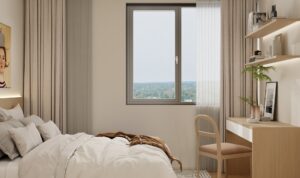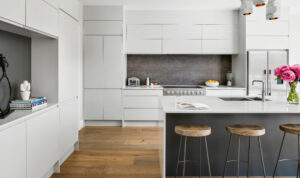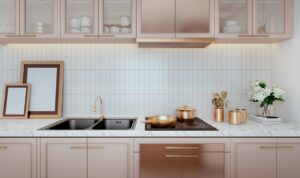Living in a small space doesn’t have to mean sacrificing style or comfort. In fact, minimalism can transform your compact home into a beautifully functional, spacious retreat. The minimalist approach to design is all about creating a calm, clutter-free environment by embracing simplicity, organization, and intentionality. When executed well, minimalism can make even the tiniest apartment or room feel expansive and open, maximizing every inch without feeling overcrowded.
In this article, we’ll uncover space-saving secrets that harness the power of minimalist design to make your small space feel grand, stylish, and inviting.
1. Embrace Neutral and Light Colors
Color plays a huge role in making a space feel larger and more open. In small spaces, it’s essential to use a light color palette that reflects light and creates the illusion of space. Neutral colors such as whites, soft grays, and beige are perfect for minimalist designs as they create a sense of calm and allow other elements in the room to stand out.
Walls and Ceilings: Painting walls and ceilings in light, neutral tones helps to brighten the space and make it feel airy. White, off-white, and light gray can open up the room, providing a blank canvas for furniture and decor.
Accents: Add subtle touches of color with pastel hues, muted tones, or metallic accents in furniture or decor items. Soft greens, blues, and even earth tones can add warmth and dimension to the room without overwhelming it.
Flooring: Light wood floors or light-colored rugs further enhance the spacious feel of a room by reflecting light and blending seamlessly with the overall neutral theme.
By sticking with a neutral color palette, you create a more open, calming environment that’s perfect for smaller spaces.
2. Declutter and Choose Only the Essentials
Minimalism’s most important principle is decluttering. A minimalist space thrives on intentionality—each item should serve a purpose or contribute aesthetically to the room. For small spaces, less really is more. Clutter can make even the largest room feel cramped and chaotic, so it’s crucial to only keep what you truly need and love.
Keep Surfaces Clear: Avoid overcrowding tables, countertops, and shelves with unnecessary items. A clean, open surface creates the illusion of more space and lets the furniture and decor breathe.
Functional Decor: Choose decor that serves both an aesthetic and functional purpose. For example, a stylish storage basket can store throws while doubling as a decorative piece. A sculptural wall clock adds beauty and functionality.
Storage Solutions: Invest in storage solutions that keep items out of sight. Built-in shelves, under-bed storage, and furniture with hidden compartments (such as storage ottomans or coffee tables) can help organize your space while minimizing clutter.
By decluttering and keeping only the essentials, your small space will instantly feel more spacious, organized, and serene.
3. Maximize Vertical Space
When working with a small area, vertical space is your best friend. Utilizing wall space for storage and decor not only frees up floor space but also adds dimension to the room. Instead of spreading out horizontally, maximize the use of your walls to create more storage and enhance the overall design.
Wall-Mounted Shelves: Install floating shelves to store books, decor, or kitchen essentials. This allows you to keep the floor clear while adding visual interest to your walls.
Tall Furniture: Opt for tall bookshelves, cabinets, and storage units that reach toward the ceiling. This maximizes storage while taking up minimal floor space, making your room feel taller and more expansive.
Hanging Items: Consider hanging lamps, baskets, or artwork to keep items off the floor and give the space an open, airy feel.
By using vertical storage and decor, you can expand your living space without compromising on functionality.
4. Invest in Multi-Functional Furniture
In small spaces, every piece of furniture should have a dual purpose to maximize functionality. Multi-functional furniture is a game-changer when it comes to minimalist design. The goal is to reduce the number of large, bulky pieces and opt for items that can serve more than one purpose.
Sofa Beds: A sofa that converts into a bed is ideal for small apartments or guest rooms. It allows you to have a comfortable seating area during the day and a cozy sleeping space at night without sacrificing room for both.
Storage Ottomans: These versatile pieces serve as both footrests and storage solutions. You can hide extra blankets, pillows, or other items inside, keeping the room tidy and organized.
Fold-Out Tables: Look for fold-out desks or dining tables that can be tucked away when not in use. These pieces are perfect for homes with limited space and can be unfolded when needed.
Nesting Tables: A set of nesting tables provides flexible functionality. They can be stacked when not in use, saving space, or pulled apart when extra surfaces are needed.
Investing in multi-functional furniture allows you to reduce the amount of physical space consumed by furnishings while still enjoying all the comforts you need.
5. Use Mirrors to Create the Illusion of Space
Mirrors are one of the most effective space-enhancing tools in a small apartment. Not only do they add a decorative touch, but they also reflect light and make the space feel larger by visually expanding the room. Placing mirrors strategically throughout your apartment can create the illusion of depth and space.
Large Wall Mirrors: A large mirror placed on one wall can make a room feel much larger and more open. It reflects both light and the room’s decor, making the space appear brighter.
Mirrored Furniture: Consider furniture with mirrored surfaces or glass elements that reflect light and add dimension to your space. For instance, mirrored tables or chairs can open up a room visually.
Reflective Surfaces: Integrate reflective surfaces such as glossy finishes on cabinets or furniture to amplify the sense of space.
Mirrors are an elegant and simple solution to visually expand your small living space while adding a touch of sophistication.
6. Create Open Pathways and Flow
In small spaces, flow is essential to making the room feel larger. Avoid blocking off areas with excessive furniture or decor. The key is to maintain clear pathways and allow the space to “breathe.”
Room Layout: Choose a layout that emphasizes openness and flow. For instance, arrange furniture in a way that promotes ease of movement and avoids obstructing natural pathways.
Minimalistic Design: Keep furniture pieces simple and streamline, focusing on the essentials to reduce visual clutter and allow the space to feel more open.
When a space flows well, it gives the impression of openness and makes it easier to navigate, thus enhancing the feeling of space.
7. Lighten Up with Smart Lighting
Lighting plays a pivotal role in creating an airy, open feeling in a small space. Well-placed lighting not only adds warmth but also enhances the perceived size of a room.
Ambient Lighting: Use soft, warm lighting to create an inviting atmosphere. Consider recessed lighting or wall-mounted fixtures to save space and provide a soft glow throughout the room.
Task Lighting: Incorporate task lighting, such as pendant lights or desk lamps, for specific areas like reading nooks or workspaces.
Natural Light: Make the most of natural light by using light, breezy curtains or shades that allow sunlight to flood the space during the day.
Smart lighting creates a sense of openness and comfort, brightening up the room and making it feel larger and more inviting.
8. Opt for Simple and Sleek Decor
In minimalist design, less is more. When choosing decor items, opt for simple, elegant pieces that serve both form and function. Avoid cluttering surfaces with too many decorative items.
Artwork: Choose large, statement pieces of art that create visual interest without overwhelming the space. Abstract or modern art can add depth and sophistication.
Minimal Accessories: Instead of filling the space with knick-knacks, choose simple, purposeful decor like a sculptural vase, a few well-placed candles, or a single plant.
By selecting a few carefully chosen decor items, you can keep your space uncluttered while still infusing it with personality and style.
Conclusion: Elevate Your Small Space with Minimalism
Minimalism is the perfect design solution for transforming a small space into a grand, functional, and stylish environment. By using light colors, multi-functional furniture, smart storage solutions, and sleek decor, you can create a home that feels spacious, serene, and sophisticated. Minimalism allows you to embrace the beauty of simplicity, freeing your home from unnecessary clutter and maximizing every inch of space.
With these space-saving secrets, your tiny apartment can become a grand, elegant retreat where you can relax, entertain, and truly enjoy the comforts of a well-designed home.






